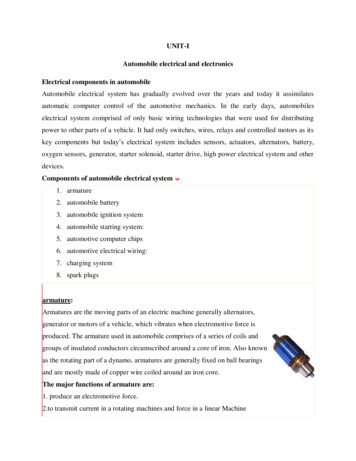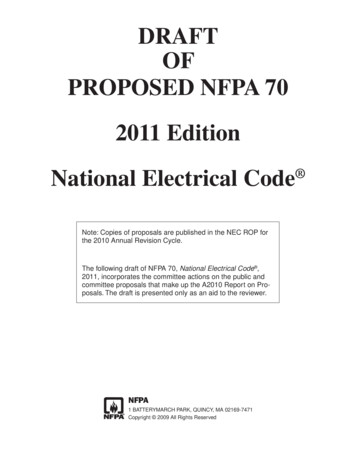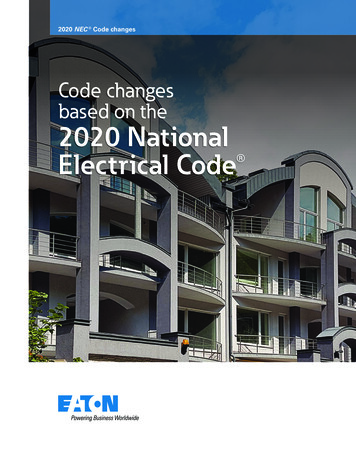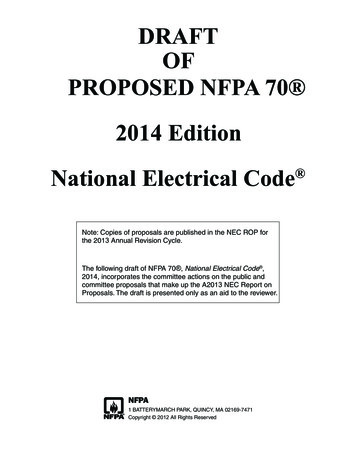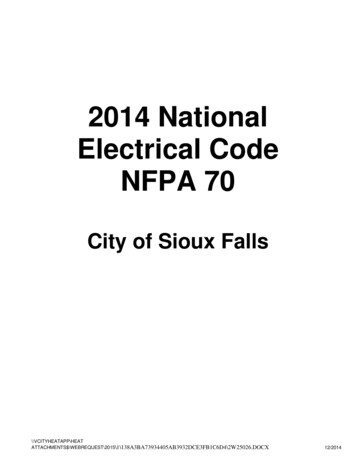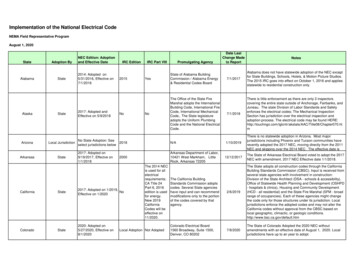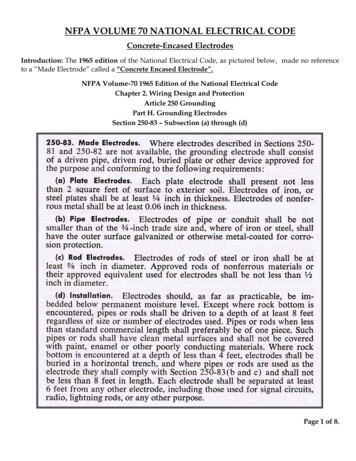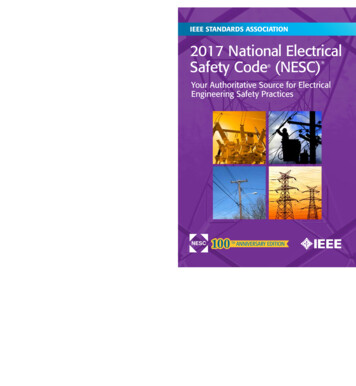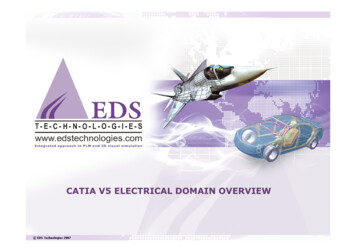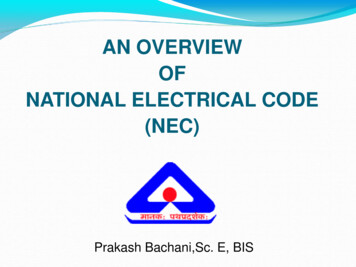
Transcription
AN OVERVIEWOFNATIONAL ELECTRICAL CODE(NEC)Prakash Bachani,Sc. E, BIS
Focus of the presentation Objectives of BIS Process of developing Standardization culture Involvement of all concerned in the process ofStandardization through consensus Need for developing/improvement in MeteringStandards Areas covered in Energy Metering Thrust on new areas as well as enhancement of thescope of the earlier version of Energy Meter Need to give wider coverage in key area of activities
Objectives Harmonious development of– Standards– Marking– Quality Certification Provide new thrust to– Standardization– Quality Control To evolve a national strategy for according recognition tostandards and integrating them withdevelopment of production and exportsgrowthand
Structure for development of Standards
Standards are made with following in mind
0 to 90 Days)F-DRAFTSTANDARDADOPTION -- DIVISIONCOUNCILNATIONALSTANDARD
Electricity Statistics in India Total Installed Capacity – Increasedfrom 16,271 MW in 1971 to 249,488MW as on 30-06-2014.Geographical DistributionNorthern Region – 26.54%Western Region – 36.32%Southern Region – 23.64%Eastern Region – 12.29%North-Eastern Region – 1.16
Electricity Statistics in India Total Installed Capacity – Increasedfrom 16,271 MW in 1971 to 249,488MW as on 30-06-2014.Geographical DistributionNorthern Region – 26.54%Western Region – 36.32%Southern Region – 23.64%Eastern Region – 12.29%North-Eastern Region – 1.16
Electricity Generation Sources Thermal – 172286.09MW (69%) Hydro – 40730.09MW (16.3%) Nuclear – 4780.00MW (1.9%) New and Renewable – 31692.14MW(12.8%)
Power Stations under GSECLNameType of FuelCapacity (MW)Ukai Thermal Power StationCoal850[2]Gandhinagar Thermal Power Station Coal870Wanakbori Thermal Power StationCoal1470Sikka Thermal Power StationCoal240Kutch Lignite Thermal Power Station Lignite290Dhuvaran Gas Based CCPPGas219[3]Utran Gas Based Power StationGas510Ukai Hydro Power StationHydro300Kadana Hydro Power StationHydro242Panam Canal Mini Hydro Power StationHydro2[4]GSECL is also serving Sardar Sarovar Narmada Nigam LimitedHydro-electric project by O&M contract.
NATIONAL ELECTRICAL CODE 2011 National Electrical Code is under the scope ofElectrical Installations Sectional Committee, ETD20 ETD 20 is one of the 37 committees under ElectroTechnical Division Council of Bureau of IndianStandards Members of the Committee are from CEA, gners, engineers and contractors Standards and Codes are prepared through aprocess of consultation, consensus and publiccomment
SCOPE OF ETD 20 To prepare standards for safety and relatedmatters in designing, erection and maintenance ofelectrical installations from the point of view ofsafety and good practice that would, amongstother things, promote compatibility between suchstandards and those concerning the equipmentinstalled. The work includes electrical installations inbuildings for different occupancies and outdoorsites of temporary or permanent nature and alsoinstallations in the ships The standards to be prepared will not cover codespertaining to individual equipment.
SCOPE OFNATIONAL ELECTRICAL CODEThe National Electrical Code covers the following: a) Standard good practices for selection of various items ofelectrical equipment forming part of power systems; b) Recommendations concerning safety and related matterin the wiring of electrical installations of buildings orindustrial structures, promoting compatibility between suchrecommendations and those concerning the equipmentinstalled. c) General safety procedures and practices in electricalwork; and d) Additional precautions to be taken for use of electricalequipment for special environmentalexplosive and active atmosphere.conditionslike
NEC APPLIES TO: Standby generating plants Building substations Domestic dwellings Office buildings Shopping and commercial centres Institutions Recreation and other public premises Medical establishments
NEC APPLIES TO: Hotels Sports buildings Industrial premises Temporary and permanent outdoor installations Agricultural premises Installations in hazardous areas Solar Photovoltaic installations
NEC DOES NOT APPLY TO: Traction, motor vehicles, installations in rolling-stock, on board-ships, aircraft or installations inunderground mines Systems of distribution of energy to public Power generation and transmission for suchsystems Guidelines on the payment for electrical workdone in installations
NEC CONTENTS Part 1 General and Common Aspects (20 Sections) Part 2 Electrical installations in stand by generating stations and captivesubstations Part 3 Electrical installations in non-industrial buildings (7 sections) Part 4 Electrical installations in industrial buildings Part 5 Outdoor installations ( 3 sections) Part 6 Electrical installations in agricultural premises Part 7 Electrical installations in Hazardous area Part 8 Solar Photovoltaic (PV) power supply systems
NATIONAL ELECTRICAL CODE Contains guidelines which can be adopted immediately Harmonized with corresponding IEC standards Code is intended to be advisory Code is not mandatory Should be adopted in interest of safety and economy Keep our electrical installation practices at par with thebest international practices
Alternating currentWinding- DeltaWinding- StarContactorLampStar-Delta Starter
Alphanumeric Notation, GraphicalSymbols and ColoursSupply acsystemsPhase 1L1RedPhase 2L2YellowPhase 3L3BlueNeutralNBlack
TYPICAL WIRING FOR REMOTE/AUTO CONTROL
New areas/enhancement of the scope ofsome areas Solar Photovoltaic (PV) power supply systems Protection against voltage surge Electronic Items Capacitor bank- Energy efficiency – Project on APFCPenal on LV side Wiring - Revision of IS 732 – Wiring of ElectricInstallation under progress Lighting – National Lighting Code (NLC)
Solar Photovoltaic (PV) In view of the importance of decentralized and distributed applications of solarphotovoltaic energy and the potential of solar lighting systems following have beenconsidered important:Solar water pumps and other solar power-based rural applications in changingthe face of India’s rural economy Growing usage of SPV in a number of products under various schemes of theMNRE Initiative by BIS Solar Photovoltaic Energy systems sectional committee, ETD 28 has taken upformulation of specific product standards covering the various products in voguehaving SPV applications including Solar Lantern as well as Solar water pumps. The standards are already under development addressing LED based solarlanterns.
Solar Photovoltaic (PV) In view of the importance of decentralized and distributed applications of solarphotovoltaic energy and the potential of solar lighting systems following have beenconsidered important:Solar water pumps and other solar power-based rural applications in changingthe face of India’s rural economy Growing usage of SPV in a number of products under various schemes of theMNRE Initiative by BIS Solar Photovoltaic Energy systems sectional committee, ETD 28 has taken upformulation of specific product standards covering the various products in voguehaving SPV applications including Solar Lantern as well as Solar water pumps. The standards are already under development addressing LED based solarlanterns.
BASIC STRUCTURE OF PV CELL
NATIONAL ELECTRICAL CODE Contains guidelines which can be adoptedimmediately Harmonized with corresponding IEC standards Code is intended to be advisory Code is not mandatory Should be adopted in interest of safety andeconomy Keep our electrical installation practices at par withthe best international practices
Considered effort for briningawareness in key areas
NATIONAL ELECTRICAL CODESP 30 : 2011 NATIONAL ELECTRICAL CODEAvailable at BIS Sales officesAvailable for online sale at BIS sales portalwww.standardsbis.in
Thank Youfor yourattention
NEC DOES NOT APPLY TO: Traction, motor vehicles, installations in rolling-stock, on board-ships, aircraft or installations in underground mines Systems of distribution of energy to public Power generation and transmission for such systems Guidelines on the payment for electrical work done in installations

